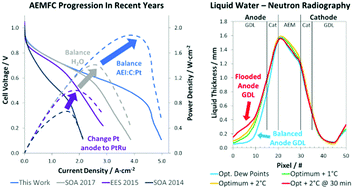Beyond catalysis and membranes: visualizing and solving the challenge of electrode water accumulation and flooding in AEMFCs†
Abstract
A majority of anion exchange membrane fuel cells (AEMFCs) reported in the literature have been unable to achieve high current or power. A recently proposed theory is that the achievable current is largely limited by poorly balanced water during cell operation. In this work, we present convincing experimental results – coupling operando electrochemical measurements and neutron imaging – supporting this theory and allowing the amount and distribution of water, and its impact on AEMFC performance, to be quantified for the first time. We also create new electrode compositions by systematically manipulating the ionomer and carbon content in the anode catalyst layer, which allowed us to alleviate the mass transport behavior limitations of H2/O2 AEMFCs and achieve a new record-setting peak power density of 1.9 W cm−2 – a step-change to existing literature. Our efforts cast a new light on the design and optimization of AEMFCs – potentially changing the way that AEMFCs are constructed and operated.

- This article is part of the themed collection: 2018 Energy and Environmental Science HOT Articles


 Please wait while we load your content...
Please wait while we load your content...